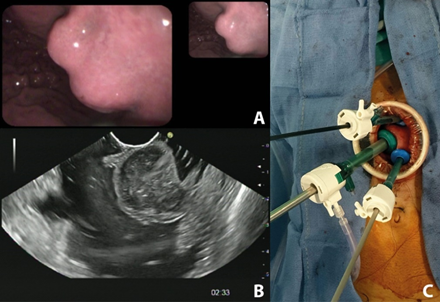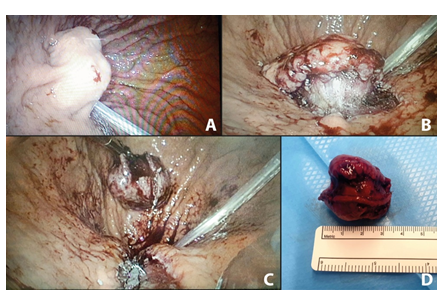A Hybrid Approach for a Minimally Invasive Resection of a Gastrointestinal Stromal Tumor
Article Information
Frey Sébastien1,2*, Maubert Alexandre1,2, Benizri Emmanuel1,2
1Côte d´Azur University, Nice, France
2Department of Digestive Surgery, University Hospital Center of Nice, Nice, France
*Corresponding Author: Frey Sébastien, Côte d´Azur University, Nice, France
Received: 01 June 2020; Accepted: 10 June 2020; Published: 18 June 2020
Citation: Frey Sébastien, Maubert Alexandre, Benizri Emmanuel. A Hybrid Approach for a Minimally Invasive Resection of a Gastrointestinal Stromal Tumor. Journal of Surgery and Research 3 (2020): 160-162.
View / Download Pdf Share at FacebookAbstract
Intragastric laparoscopic surgery has been described for the resection of gastric benign tumor located near the gastroesophageal junction. We describe here the resection of a benign tumor using a multiport intragastric laparoscopic approach. The surgery was safe and effective. Post-operative follow-up was uneventful.
Keywords
Gastrointestinal Stromal Tumor, Intragastric laparoscopic
Gastrointestinal Stromal Tumor articles, Intragastric laparoscopic articles
Gastrointestinal Stromal Tumor articles Gastrointestinal Stromal Tumor Research articles Gastrointestinal Stromal Tumor review articles Gastrointestinal Stromal Tumor PubMed articles Gastrointestinal Stromal Tumor PubMed Central articles Gastrointestinal Stromal Tumor 2023 articles Gastrointestinal Stromal Tumor 2024 articles Gastrointestinal Stromal Tumor Scopus articles Gastrointestinal Stromal Tumor impact factor journals Gastrointestinal Stromal Tumor Scopus journals Gastrointestinal Stromal Tumor PubMed journals Gastrointestinal Stromal Tumor medical journals Gastrointestinal Stromal Tumor free journals Gastrointestinal Stromal Tumor best journals Gastrointestinal Stromal Tumor top journals Gastrointestinal Stromal Tumor free medical journals Gastrointestinal Stromal Tumor famous journals Gastrointestinal Stromal Tumor Google Scholar indexed journals Intragastric laparoscopic articles Intragastric laparoscopic Research articles Intragastric laparoscopic review articles Intragastric laparoscopic PubMed articles Intragastric laparoscopic PubMed Central articles Intragastric laparoscopic 2023 articles Intragastric laparoscopic 2024 articles Intragastric laparoscopic Scopus articles Intragastric laparoscopic impact factor journals Intragastric laparoscopic Scopus journals Intragastric laparoscopic PubMed journals Intragastric laparoscopic medical journals Intragastric laparoscopic free journals Intragastric laparoscopic best journals Intragastric laparoscopic top journals Intragastric laparoscopic free medical journals Intragastric laparoscopic famous journals Intragastric laparoscopic Google Scholar indexed journals gastric benign tumor articles gastric benign tumor Research articles gastric benign tumor review articles gastric benign tumor PubMed articles gastric benign tumor PubMed Central articles gastric benign tumor 2023 articles gastric benign tumor 2024 articles gastric benign tumor Scopus articles gastric benign tumor impact factor journals gastric benign tumor Scopus journals gastric benign tumor PubMed journals gastric benign tumor medical journals gastric benign tumor free journals gastric benign tumor best journals gastric benign tumor top journals gastric benign tumor free medical journals gastric benign tumor famous journals gastric benign tumor Google Scholar indexed journals endogastric articles endogastric Research articles endogastric review articles endogastric PubMed articles endogastric PubMed Central articles endogastric 2023 articles endogastric 2024 articles endogastric Scopus articles endogastric impact factor journals endogastric Scopus journals endogastric PubMed journals endogastric medical journals endogastric free journals endogastric best journals endogastric top journals endogastric free medical journals endogastric famous journals endogastric Google Scholar indexed journals Per-operative endogastric articles Per-operative endogastric Research articles Per-operative endogastric review articles Per-operative endogastric PubMed articles Per-operative endogastric PubMed Central articles Per-operative endogastric 2023 articles Per-operative endogastric 2024 articles Per-operative endogastric Scopus articles Per-operative endogastric impact factor journals Per-operative endogastric Scopus journals Per-operative endogastric PubMed journals Per-operative endogastric medical journals Per-operative endogastric free journals Per-operative endogastric best journals Per-operative endogastric top journals Per-operative endogastric free medical journals Per-operative endogastric famous journals Per-operative endogastric Google Scholar indexed journals Upper endoscopy articles Upper endoscopy Research articles Upper endoscopy review articles Upper endoscopy PubMed articles Upper endoscopy PubMed Central articles Upper endoscopy 2023 articles Upper endoscopy 2024 articles Upper endoscopy Scopus articles Upper endoscopy impact factor journals Upper endoscopy Scopus journals Upper endoscopy PubMed journals Upper endoscopy medical journals Upper endoscopy free journals Upper endoscopy best journals Upper endoscopy top journals Upper endoscopy free medical journals Upper endoscopy famous journals Upper endoscopy Google Scholar indexed journals intragastric laparoscopic surgery articles intragastric laparoscopic surgery Research articles intragastric laparoscopic surgery review articles intragastric laparoscopic surgery PubMed articles intragastric laparoscopic surgery PubMed Central articles intragastric laparoscopic surgery 2023 articles intragastric laparoscopic surgery 2024 articles intragastric laparoscopic surgery Scopus articles intragastric laparoscopic surgery impact factor journals intragastric laparoscopic surgery Scopus journals intragastric laparoscopic surgery PubMed journals intragastric laparoscopic surgery medical journals intragastric laparoscopic surgery free journals intragastric laparoscopic surgery best journals intragastric laparoscopic surgery top journals intragastric laparoscopic surgery free medical journals intragastric laparoscopic surgery famous journals intragastric laparoscopic surgery Google Scholar indexed journals
Article Details
Case Report
A 54-year-old male underwent, in our digestive surgery department, a gastrointestinal stromal tumor (GIST) resection performed with a multiport laparoscopic intragastric approach. A 3 cm tumor was diagnosed after a full check-up (CT-scan, upper endoscopy and endoscopic ultrasound) for chronic abdominal pain, located on the lesser curvature near the esogastric junction (Figure 1).
During the procedure, the patient was placed in a dorsal decubitus position and the lead surgeon stood on its right side. Open laparoscopy showed no local invasion nor secondary lesion. We then performed a 5 cm medial laparotomy by extending the camera port incision. An Alexis® retractor was inserted. We were able to palpate the tumor and confirm its endogastric development. Laparoscopic intragastric access was then performed using a camera port of 10 mm, a 5 mm exposure port and a 12 mm working port (Figure 1). Resection was done using an Endo-GIA stapler with two 45 cartridges after mucosal dissection (Figure 2).

Figure 1: (a) Upper endoscopy view and (b) endoscopic ultrasound view of the tumor; (c) Per-operative view of intragastric trocar placement.

Figure 2: Per-operative endogastric view: (a) at the introduction of scope; (b) after mucosal dissection; (c) after stapling; (d) Tumor resected measuring 32 mm.
The success of this hybrid technique is due to the excellent visibility along with the possibility for a safe and a full-thickness resection. Post-operative follow-up was uneventful and discharge was authorized at day 2. Pathological examination confirmed a GIST with a clear margin. Since the first description of intragastric laparoscopic surgery in 1995, more technical and tactical advancements have been described [1, 2]. Its use for benign gastric lesions resection is now part of the surgeon arsenal, especially for tumor located near the esogastric junction (EGJ). In more recent years, the laparoscopic and endoscopic cooperative approach has been well accepted [3]. However, the endoscopic technical platform is not always accessible and the present case illustrate an easy and efficient alternative. Additionally, surgical site infection is not uncommon during full intragastric laparoscopic procedures. In our case, an Alexis® was used, offering a great exposure but also conferring a protective role of the abdominal wall. All in all, since its first description, intragastric laparoscopic surgery can be considered feasible and represents a great alternative for benign intragastric tumor resection.
Funding/Support
None of the authors has any financial interest or support to report.
Conflict of Interest/Disclosure
All authors declare that they have no conflict of interest or financial relationships, direct or indirect, with other people or organizations that could potentially and inappropriately influence the work and conclusions.
Acknowledgement
No funding was received for this study.
References
- Conrad C, Nedelcu M, Ogiso S, et al. Techniques of intragastric laparoscopic surgery. Surg Endosc 29 (2015): 202-206.
- Boulanger-Gobeil C, Gagné J-P, Julien F, et al. Laparoscopic Intragastric Resection: An Alternative Technique for Minimally Invasive Treatment of Gastric Submucosal Tumors. Annals of Surgery 267 (2018): 12-16.
- Hiki N, Nunobe S, Matsuda T, et al. Laparoscopic endoscopic cooperative surgery: Present and future aspects of LECS. Digestive Endoscopy 27 (2015): 197-204.
